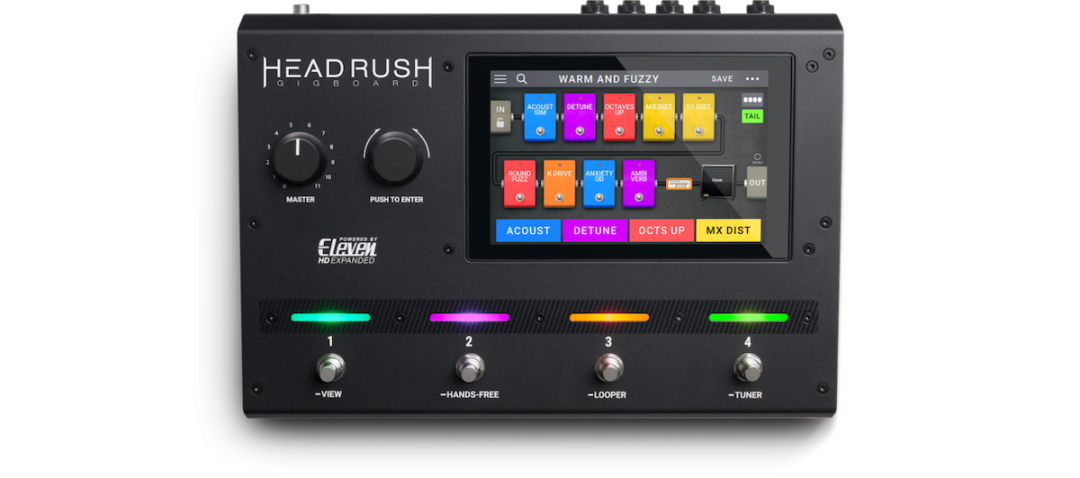We’ve seen a lot of amp sims and multi-effects pedals, and now we’ll be checking out the Headrush Gigboard in this rundown and review.
What Is the Headrush Gigboard?
The Gigboard by Headrush is a compact amp modeler and multi-effects unit. It’s based on the brand’s flagship Pedalboard modeler, but with more refined features to shrink it into a smaller chassis. Don’t be fooled by its size, however, as the Gigboard is still an advanced and highly capable centerpiece of a complete guitar rig.
With a roomy 7″ touchscreen and four footswitches, the Gigboard doesn’t intimidate or overwhelm at first glance, making it an intuitive and approachable modeler for any level of player.
What Does Gigboard Offer?
Gigboard currently offers 50 amplifiers, 15 cabinets with 10 microphones, 300 impulse responses, and over 65 effects. The library contains every number of classic and modern favorites, so you could easily piece together a chain for just about any tone imaginable. All of this is housed in a tough-as-nails steel chassis, making it a tour-ready board for gigging guitarists. Gigboard’s compact frame makes it incredibly easy to throw in a backpack and cart to the studio, the stage, or anywhere in between.
Headrush Gigboard Review: The Last Effects Processor You Will Need?
There’s lots of competition in the world of hardware amp/effect modelers. The fact is that emulation has gotten so good that it’s leading relative newcomers like Headrush to develop these products in order to have a horse in the race, so to speak. And what Headrush did with their flagship modeler has led other developers to pursue more compact alternatives to rackmount pieces or otherwise.
- RELATED: The Best Modeling Amps to Elevate Your Guitar Sounds
- RELATED: 20 Best Virtual Amp Sims
The Headrush Gigboard is an overall excellent middle-ground where it feels fully featured but totally portable with no bloat whatsoever.
Specs & Power Requirements
Gigboard features a quad-core processor and Eleven HD Expanded DSP software to power its signal chains. The 7″ touchscreen is where most of the work happens, and it feels snappy and responsive. Building out a rig is as easy and drag and dropping pieces. The unit runs on an included 19V power adapter.
Functionality & User Interface
The touchscreen truly sets Gigboard apart from any units that lack one. It really makes the unit so approachable that virtually anyone wrap their head around it in a short period of time. Apart from Headrush’s intuitive rig building, the screen is bright, high-definition, and ultra-responsive. Functionally, Gigboard is a superior product that declutters the virtual signal chain process.
Presets
Gigboard includes nearly 300 factory presets. This would take a long time to comb through, but it’s worth taking the time to identify the sounds you like and built custom presets using them as a foundation. You can also join the Headrush community and download more official presets from the company or from other users.
How Does It Sound?
The Headrush stuff is completely on par with any of the most popular or most well known modelers on the market. Much of its sonic resolution is thanks to not only the meticulous modeling of famous gear, but also its custom DSP engine. There’s a lot of power in this unit, and it can certainly be heard.
Pros & Cons of Using Headrush Gigboard
One of the Gigboard’s biggest pros is its usability. It’s actually fun to jump in and create rigs, which is a rare statement when it comes to how clunky most other multi-effects processors are. Nothing feels unreasonably tedious, so intuitiveness is a major pro.
Sonically, Headrush does a phenomenal job of recreating the feel of playing through real amps — another huge pro. It’s difficult to describe the connection between a guitar and a real amplifier, but anyone who’s been playing for some time knows that responsiveness and feel. A lot of modelers just don’t nail that at all, and it feels like you’re playing through a digital emulation. Thankfully, that’s not the case with Headrush.
As far as drawbacks go, the collection of amps and particularly effects is comparatively more limited than competitors such as Line 6. However, Headrush contains all of the essentials, and for most players, that’s probably more than enough. We could make the argument that time-based effects also lack a bit of oomph or serious depth, though it’s a minor complaint overall.
Headrush MX5 vs. Gigboard: Which Is Better for Me?
As far as the included amps, effects, and cabinets go, MX5 and Gigboard are identical. The MX5 adds a built-in expression pedal, which can be very convenient for a lot of players. Remarkably, the MX5 is actually smaller than the Gigboard, taking the portable pedalboard format to new levels. It scales down the touchscreen to 4″ and removes one footswitch in favor of the expression pedal. If you’re all for flat-out portability, the MX5 is pretty incredible. Otherwise, some players may prefer a the larger touchscreen for its additional usability.
Our Take: Headrush Gigboard Is a Remarkably User-Friendly Amp Sim & Effects Processor
If there’s any singular thing that Headrush has simply crushed, it’s intuitiveness. The same just can’t be said for most modelers; there’s often a steep learning curve, and it feels really tedious in order to get the most out of your signal chains. Headrush has seemingly done what’s been impossible for others, by streamlining the whole rig creation process and making it easy for players to get in, make amazing tones, and have fun.
